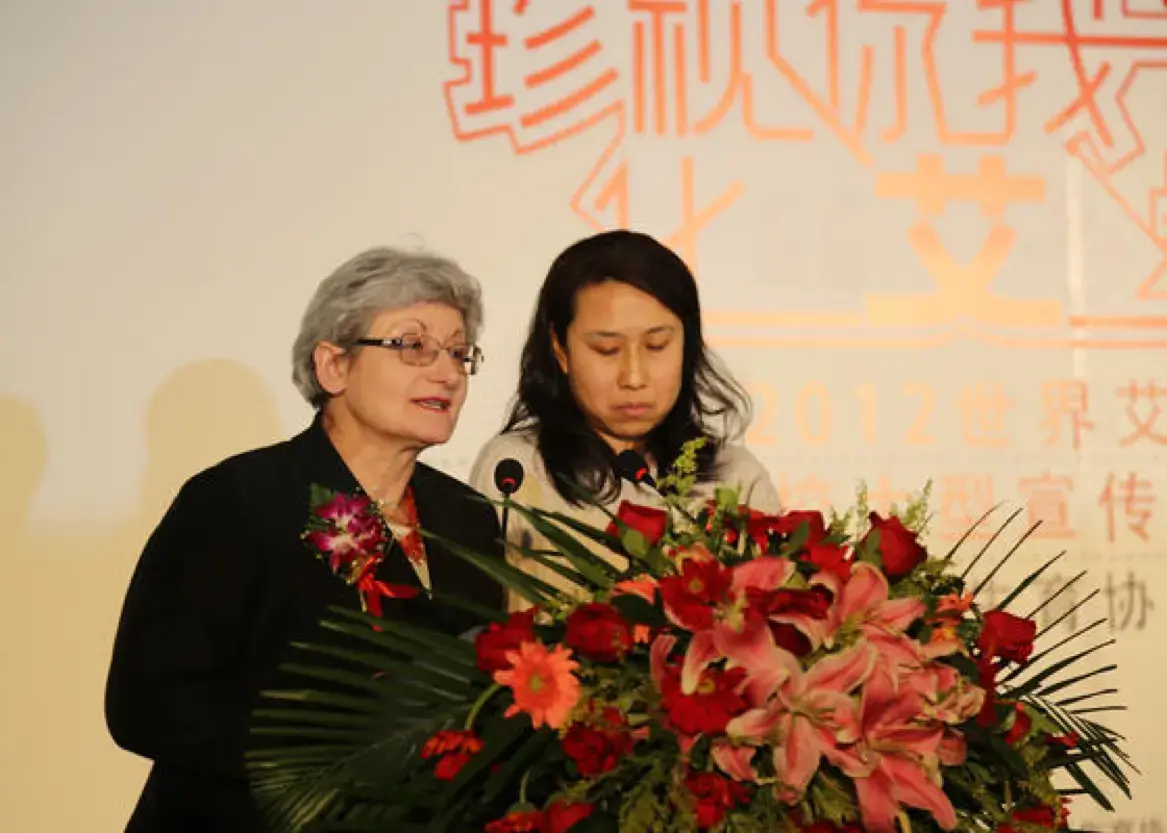This year’s World AIDS Day’s theme, Hands Up for Prevention, reminds us that we still have work to do to reduce HIV transmission if we are to meet the global target set out in the UN Political Declaration on Ending AIDS adopted by the UN General Assembly in June 2016. In order to end AIDS by 2030, the HIV response must be fast tracked and that includes reducing new HIV infections to less than 500,000 by 2020.
In China, the government has led a national HIV response that has, over the last twenty years, significantly reduced HIV transmission and improved the health and wellbeing of people living with HIV. Today, the HIV response is largely domestically funded, with minimal financing from international donors. This support includes financing interventions by community and non-government organizations working with populations most affected by HIV – sex workers and their clients, men who have sex with men, people who use drugs and their sexual partners.
However, with a society in socio-economic transition, the HIV epidemic in the country is evolving. The proportion of newly reported HIV cases due to sexual transmission, both heterosexual and among men with men, has increased from 33.1% in 2006 to over 94% in 2015. HIV prevalence among men who have sex with men has seen a rise in the past decade from 1.4% in 2001 to 6.3% in 2011 to 8.0% in 2015. Moreover, young people are particularly vulnerable to HIV infection, in the Asia-Pacific region, 13 young people aged 15 to 24 are infected with HIV every hour, and in China, 7.1% of people living with HIV are young people.The increase in HIV prevalence among MSM and young people is worrying. The focus on other at-risk individuals needs to be sustained. While HIV prevalence among female sex workers remains low, research shows that female sex workers in China face a risk of HIV infection that is 50 times higher than women in China’s general population.
But women are still at risk of getting infections from their intimate partners. Domestic violence against women is a pervasive phenomenon, and negatively affects their physical, mental, sexual and reproductive health, hence, increasing their vulnerability to HIV. Through empowerment of women and young people, and respectful gender relationships, we can contribute to a society free from stigma and discrimination and all forms of gender-based violence.
Only 100% condom use can help prevent HIV sexual transmission. However, barriers to consistent condom use need resolving, in particular for male, female and transgender sex workers and their clients. Law enforcement practices, such as confiscation of condoms by police, deter sex workers from carrying condoms, and decreases consistent condom use and works against the peer education and prevention programmes that encourage and promote condom use.
HIV prevention efforts cannot be isolated from HIV treatment and care. When people living with HIV know their status, they can access life-saving treatment, which can also prevent HIV transmission to others.
Stigma and discrimination are major barrier to getting to know one’s HIV status – and more so, among individuals from particular sub-populations such as men who have sex with men, sex workers and their clients, and people who inject drugs. That is why each contact with health services is an invaluable opportunity to provide HIV services as the individual may not come back later for fear of stigma and rejection.
Innovative technologies, such as rapid HIV testing delivered in communities, are vital to take HIV testing further to hard-to-reach sub-populations. The new WHO guidelines released during this World AIDS Day recommends HIV self-testing as an additional approach. This would mean that people of any age, gender and sexual orientation can access HIV oral or finger-prick rapid testing in private, in order to screen themselves for HIV. This would be a major step forward in knowing one’s HIV status.
Although innovative HIV rapid tests for self-testing are available in China, regulatory barriers prevent wide access to it, and universal access to HIV testing is yet to be achieved. Of course, if the self-test is positive – people need to get access to treatment and care services.
China has achieved remarkable success in providing universal access to free antiretroviral treatment (ART) – with over 420,000 people living with HIV on ART. Antiretroviral treatment prevents progression of disease and keeps people healthy. Moreover, treatment also helps to prevent HIV transmission and has been used to prevent mother-to-child transmission, as well as oral pre-exposure prophylaxis (PrEP) which is providing antiretroviral drugs to people who are HIV-negative and at substantial risk of HIV infection, in order to prevent HIV infection.
This continuum of HIV testing and treatment services cannot happen without sustained efforts on prevention interventions including knowledge and education on HIV, comprehensive sexuality education for all young people, strengthening access of sexually transmitted infection (STI) treatment services, as well as access to condoms and lubricants in particular sex workers, their clients, men who have sex with men, and people who use drugs and their partners. China has made significant strides in its national response to HIV. To get to ending AIDS in China – sustained efforts in HIV prevention, universal access to HIV testing and treatment would be next phase forward. The United Nations in China is committed to support accelerating universal access to HIV prevention, testing and treatment so that China’s vision to fast track towards ending AIDS by 2030 will be achieved.
This Op-ed is issued by the following UN agencies in China: UNAIDS, UNFPA, WHO, UN Women, UNICEF, UNESCO, UNDP and ILO



